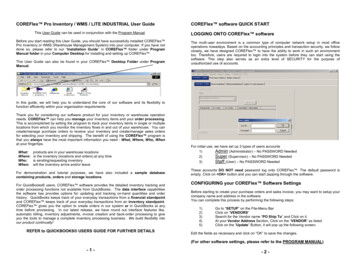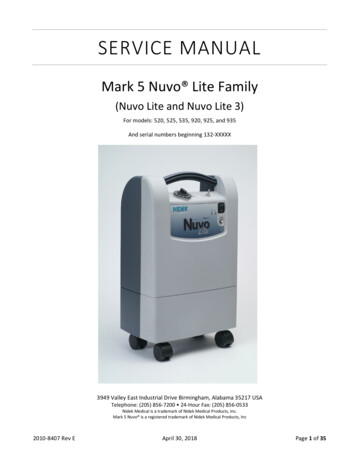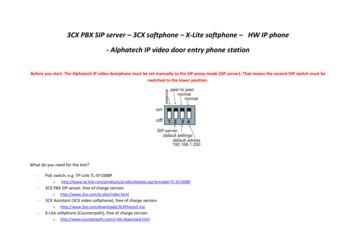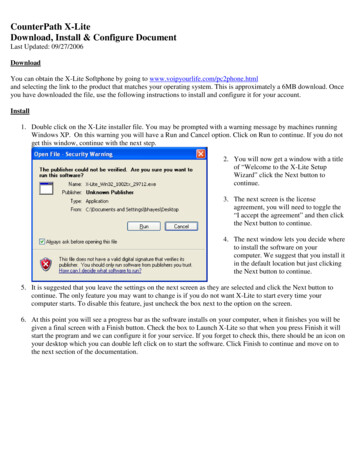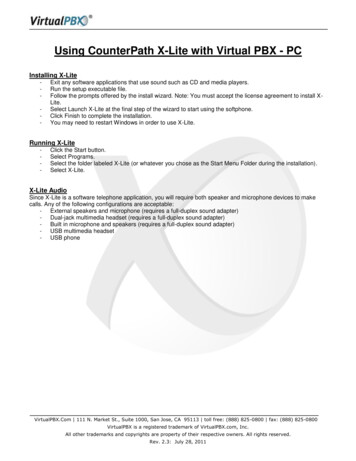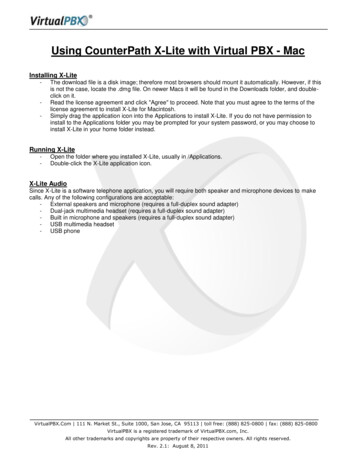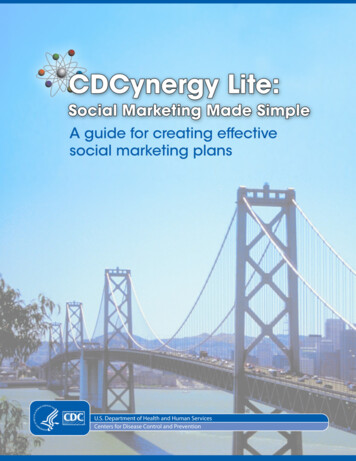
Transcription
CDCynergy Lite: Social Marketing Made SimpleA guide for creating effective social marketing plans
Social Marketing Made SimpleSocial Marketing Made Simple is a lighter version ofthe CDCynergy: Social Marketing edition product.This tool is based on best practice social marketingprinciples, and assists in developing, implementing andevaluating an effective social marketing plan. The tooltakes you step-by-step through the process, giving youinstructions on “What It Is” and “How It Is Done”. Alsoincluded are appendices that contain useful charts,forms, and questions to help one move through theplanning process.
ContentsProblem Description . . . . . . . . . . . . . . . . . . . . . . . . . . . . . . . . . . . . . 7What It Is . . . . . . . . . . . . . . . . . . . . . . . . . . . . . . . . . . . . . . . . . . . . . . . . . . . . . . . 7How It Is Done . . . . . . . . . . . . . . . . . . . . . . . . . . . . . . . . . . . . . . . . . . . . . . . . . . . . 7Tools and Templates . . . . . . . . . . . . . . . . . . . . . . . . . . . . . . . . . . . . . . . . . . . . . . . . 8Market Research . . . . . . . . . . . . . . . . . . . . . . . . . . . . . . . . . . . . . . . . . . 9What It Is . . . . . . . . . . . . . . . . . . . . . . . . . . . . . . . . . . . . . . . . . . . . . . . . . . . . . . . 9How It Is Done . . . . . . . . . . . . . . . . . . . . . . . . . . . . . . . . . . . . . . . . . . . . . . . . . . . . 9Tools and Templates . . . . . . . . . . . . . . . . . . . . . . . . . . . . . . . . . . . . . . . . . . . . . . . . 9Market Strategy . . . . . . . . . . . . . . . . . . . . . . . . . . . . . . . . . . . . . . . . . 10What It Is . . . . . . . . . . . . . . . . . . . . . . . . . . . . . . . . . . . . . . . . . . . . . . . . . . . . . . 10How It Is Done . . . . . . . . . . . . . . . . . . . . . . . . . . . . . . . . . . . . . . . . . . . . . . . . . . . 10Tools and Templates . . . . . . . . . . . . . . . . . . . . . . . . . . . . . . . . . . . . . . . . . . . . . . . 13Interventions . . . . . . . . . . . . . . . . . . . . . . . . . . . . . . . . . . . . . . . . . . . . 14What It Is . . . . . . . . . . . . . . . . . . . . . . . . . . . . . . . . . . . . . . . . . . . . . . . . . . . . . .How It Is Done . . . . . . . . . . . . . . . . . . . . . . . . . . . . . . . . . . . . . . . . . . . . . . . . . . .Timeline . . . . . . . . . . . . . . . . . . . . . . . . . . . . . . . . . . . . . . . . . . . . . . . . . . . . . . .Budgets . . . . . . . . . . . . . . . . . . . . . . . . . . . . . . . . . . . . . . . . . . . . . . . . . . . . . . .Tools and Templates . . . . . . . . . . . . . . . . . . . . . . . . . . . . . . . . . . . . . . . . . . . . . . .Evaluation . . . . . . . . . . . . . . . . . . . . . . . . . . . . . . . . . . . . . . . . . . . . . .141415151516What It Is . . . . . . . . . . . . . . . . . . . . . . . . . . . . . . . . . . . . . . . . . . . . . . . . . . . . . . 16How It Is Done . . . . . . . . . . . . . . . . . . . . . . . . . . . . . . . . . . . . . . . . . . . . . . . . . . . 16Tools and Templates . . . . . . . . . . . . . . . . . . . . . . . . . . . . . . . . . . . . . . . . . . . . . . . 19Implementation . . . . . . . . . . . . . . . . . . . . . . . . . . . . . . . . . . . . . . . . . . 20What It Is . . . . . . . . . . . . . . . . . . . . . . . . . . . . . . . . . . . . . . . . . . . . . . . . . . . . . . 20How It Is Done . . . . . . . . . . . . . . . . . . . . . . . . . . . . . . . . . . . . . . . . . . . . . . . . . . . 20Tools and Templates . . . . . . . . . . . . . . . . . . . . . . . . . . . . . . . . . . . . . . . . . . . . . . . 22Appendices . . . . . . . . . . . . . . . . . . . . . . . . . . . . . . . . . . . . . . . . . . . . . .23Appendix A: Example Problem Statements . . . . . . . . . . . . . . . . . . . . . . . . . . . . . . . . .Appendix B: Health Problem Worksheet . . . . . . . . . . . . . . . . . . . . . . . . . . . . . . . . . . .Appendix C: Conducting a SWOT analysis . . . . . . . . . . . . . . . . . . . . . . . . . . . . . . . . .Appendix D: Basic Social Marketing Questions . . . . . . . . . . . . . . . . . . . . . . . . . . . . . .Appendix E: Market Research Planning Template . . . . . . . . . . . . . . . . . . . . . . . . . . . . .Appendix F: Creative Brief Template . . . . . . . . . . . . . . . . . . . . . . . . . . . . . . . . . . . . .Appendix G: Timeline and Budget . . . . . . . . . . . . . . . . . . . . . . . . . . . . . . . . . . . . . .Appendix I: Dissemination Formats . . . . . . . . . . . . . . . . . . . . . . . . . . . . . . . . . . . . . .2323242425262627
Problem DescriptionWhat It IsThe problem description will help you keep the main goal of your social marketing effort in mind. The problemdescription clarifies what the public health problem is, who is affected, and what you propose to do to address it.A full, clear problem description and analysis will help you decide whether to undertake a social marketing effort.How It Is Done1. Write a problem statement The health problem is the gap between an acceptable or desirable health status and the current status.To write your problem statement, briefly answer these questions: What should be occurring? What is occurring? Who is affected and to what degree? What could happen if the problem isn’t addressed? Use health status indicators to answer the first 3 questions. Health status indicators are data onoutcomes or their causes (e.g., smoking rates). Health status indicator data is made available bynumerous organizations. See veinformation/index/index cat resources.htm?specificpartners for a list of organizations.2. List and map the causes of the health problem Consider the following: genetic or biological factors psychological factors behaviors factors in the physical environment (e.g., a lack of transportation) factors in the social environment (e.g., social support, or policy) Categorize the causes as direct and indirect, and as risk and protective factors. Weigh the factors anddetermine which ones are the primary factors. Determine which of these can change as a result of programmatic action? (e.g., a social marketingprogram can’t eliminate genetic risk factors)3. Identify potential audiences Grouping the audience into meaningful segments will allow you to design efficient and effectivestrategies for reaching them. Determine which audiences are: most affected by the problem most likely to change their behavior most feasible to reach key secondary audiences Avoid making audiences too broad. It is a better use of your resources to impact fewer in a moremeaningful way.7
Be sure to add to the list target audiences your program is required to reach, and additional audiencesthat could help bring about change.4. Conduct a SWOT analysis A SWOT (Strengths, Weaknesses, Opportunities and Threats) analysis assesses the factors in the broadersituation that could impact the implementation of your program or its ultimate success.Tools and TemplatesAppendix A: Example problem statementsAppendix B: Health Problem worksheetAppendix C: Guiding questions for conducting a SWOT analysis and Worksheet8
Market ResearchWhat It IsMarket research (also called consumer or audience research) is research designed to enhance your understandingof the target audience’s characteristics, attitudes, beliefs, values, behaviors, determinants, benefits and barriers tobehavior change in order to create a strategy for social marketing programs.How It Is Done1. Define your research questions. Review results of your work from phase 1 to identify information gaps; restate these gaps as researchquestions Ask basic social marketing questions (e.g., barriers/benefits of recommended behavior) Ask questions to clarify how to segment your audience (e.g., demographics, psychographics) Ask questions to assess the environment (e.g., community attitudes towards HIV)2. Develop a market research plan. Which answers can come from secondary sources and which ones require collecting new data? Which methods will be used to collect and analyze the new data? (e.g., focus groups, surveys, interviews) What order will the methods be used in?3. Conduct and analyze market research Assign roles and responsibilities for carrying out your market research plan Hire a professional market research vendor to conduct the research, or partner with a university orcommunity-based organization to do some of the work if you lack in-house expertise or staff time Approve final versions of the data collection instruments and market research procedures before datacollection begins Conduct or oversee data collection and analysis4. Summarize research results Write a market research report that presents your findings clearly and concisely. Report shouldinclude an executive summary, introduction, methodology section, results, and conclusions andrecommendations.Tools and TemplatesAppendix D: List of basic Social Marketing QuestionsAppendix E: Market Research Planning Template»» Market research results summary worksheet9
Market StrategyWhat It IsA market strategy is a plan of action for your entire social marketing program. Market strategy encompasses thespecific target audience segment(s), the specific desired behavior change goal, the benefits you will offer, and theinterventions that will influence or support behavior change.How It Is Done1. Select your target audience segment(s). Make a list of the primary audience segments you could target. Define each segment in terms of: demographics (e.g., age and race/ethnicity) behavioral determinants that distinguished “doers” from “non-doers” of your health behavior For each of the potential segments listed, pull the following information from your research findings: aspirations benefits of the target behavior valued competitive behaviors practiced information channels used level of readiness to change Then go back down the list and highlight the segments that have: perceived benefits that are easy to build into an exchange competing behaviors against which you can “win” the largest number of people reachable at the smallest cost the greatest readiness to change Decide whether to allocate some or all of your limited program resources to targeting secondaryaudience segments. These are groups that may influence your primary target audience.2. Define current and desired behaviors for each audience segment. Identify the behavior that each audience segment finalist is currently doing. To specify the behavior youwant them to do, ask yourself: What behavior could be changed in the short-run? Is it likely to change with a little more incentive? If audience members take the desired action, will it make a tangible difference in achieving myoverall program goal?3. Prioritize audience/behavior pairs To narrow your list down to the final priorities, consider the following factors for each audience/behaviorpair Risk Impact Behavioral Feasibility Resource Feasibility Political Feasibility10
4. Describe the benefits you will offer Social marketing – like commercial marketing – is based on the principle of exchange, the idea thatpeople will bear certain costs to get something of value in return. You want to offer your audience an exchange that: is easy and irresistible to accept maximizes the benefits they will get for adopting a behavior minimizes any barriers that might deter themExample:Audience Member gives:Audience Member gets: 10 Time Momentary discomfort An immunizationFreedom from illness in the futureFreedom to travelAbility to go to school Instead of asking “What does the target audience NEED (for their health)?” ask, “What does the targetaudience WANT?” Pay attention to what audience members say they value the most, and you’ll be on your way to providinga solid exchange. Enhance the exchange with each program activity by continually building in morebenefits that are obvious to and valued by the audience.5. Write your behavior change goal(s) Rewrite each audience segment/behavior couplet in the form of a benefit exchange statement thatspells out the exchange. This condensed format makes it to easier to explain the purpose of yourprogram to stakeholders and partners.For example:Parents of eligible uninsured childrenWho? (specific audience segment
SoCiaL Marketing MaDe SiMpLe Social Marketing Made Simple is a lighter version of the CDCynergy: Social Marketing edition product. This tool is based on best practice social marketing principles, and assists in developing, implementing and evaluating an effective social marketing plan. The tool takes you step-by-step through the process, giving you


